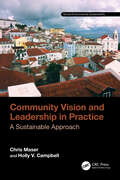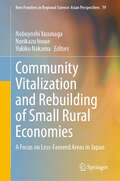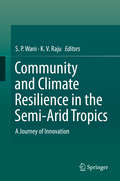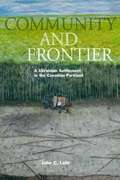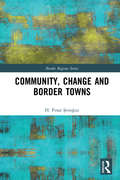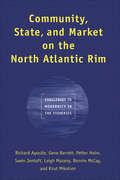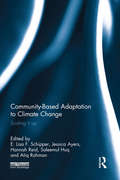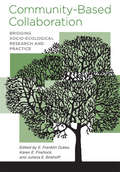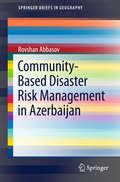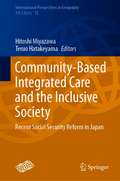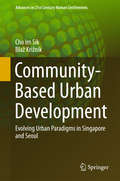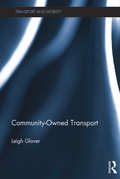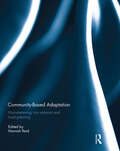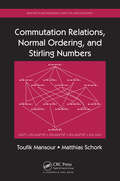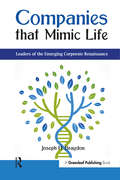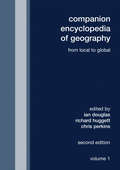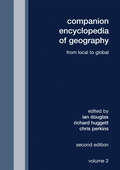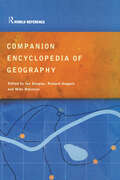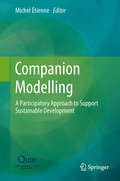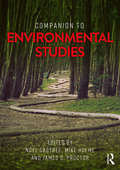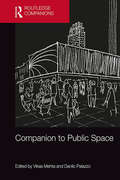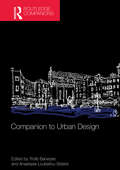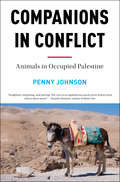- Table View
- List View
Community Vision and Leadership in Practice: A Sustainable Approach (Social-Environmental Sustainability)
by Chris Maser Holly V. CampbellThis book is about building and maintaining involved, sustainable, and inclusive communities from the ground up during a period of unprecedented growth and global change. It explains the concepts and principles of community and sustainability and provides students with a framework of sustainable community planning to put into practice. It is also designed to help communities everywhere identify and reconnect the true essence of their ecological setting with the objective of raising their quality of life by increasing social, environmental, and economic sustainability. Features: Provides up-to-date frameworks for sustainable community planning processes and case studies on community planning Explains tools for sustainable planning in accessible (non-specialist) language Illustrates a roadmap to an inclusive, collaborative future Explains aspects of sustainable community planning to maximize ecological ecosystem services and climate co-benefits simultaneously Includes discussion questions and suggestions following each chapter Intended for undergraduate and graduate students taking leadership and community courses with an emphasis on sustainable practices and ethics, as well as for citizens and professionals involved in community projects related to sustainability, the authors provide a forward-thinking approach, showing readers that they are capable of making a positive impact on the future of community development through sustainable approaches and ethical leadership practices.
Community Vitalization and Rebuilding of Small Rural Economies: A Focus on Less-Favored Areas in Japan (New Frontiers in Regional Science: Asian Perspectives #79)
by Nobuyoshi Yasunaga Norikazu Inoue Yukiko NakamaThis book provides new perceptions of rural community development by considering the relationships between communities and individuals. It addresses how farming and local communities can be maintained in areas facing population decline and increased in abandoned farmland. As a sequel to Farm and Rural Community Management in Less-Favored Areas, this book focuses on the conditions for rebuilding small rural economies through rural community vitalization in less-favored areas of Japan. Key topics addressed in the book include farmland liquidation and conservation, along with applicable agricultural policies, agribusiness development under a broad-based community development process, the market characteristics of locally processed foods, and the relationship between participation in broad-based community management and residents’ characteristics. The primary target are hilly and mountainous regions, such as in Shimane Prefecture, in western Japan, and other mountainous areas that are the main less-favored areas in Japan. The book presents findings from econometric and statistical analyses, historical and actual condition surveys. Academically, the book contributes to the elucidation of community-based regional management through interactions between communities, residents, farmers, and policies. It identifies conditions for rebuilding small rural economies are based on research on the characteristics of regional agriculture and rural communities in less-favored areas. This book is written for researchers, graduate students, and readers who are concerned about agriculture-based rural development in less-favored areas. It promotes both public and field-level practice in rural areas. The content will be of interest to all those seeking to understand rural society in Japan.
Community and Climate Resilience in the Semi-Arid Tropics: A Journey of Innovation
by K. V. Raju S. P. WaniThis book focuses on developing an integrated holistic approach for harnessing the potential of rain-fed agriculture. In this approach, rainwater management through harvesting and recharging the groundwater is used as an entry point activity for increasing the productivity for farmers through enhanced water use efficiency. To provide the holistic and integrated solutions, the approach of consortium through building partnerships with different stakeholders, eg. different research institutions (State, National and International), development departments, eg. Department of Agriculture, Department of Animal Husbandry etc., Non-Government Organizations (NGOs), Farmers Organizations Community-based Organizations (CBOs) along with market linkages through private companies.
Community and Frontier: A Ukrainian Settlement in the Canadian Parkland (Studies in Immigration and Culture #6)
by John C. LehrA social and economic history of one of the oldest Ukrainian settlements in Western Canada. Established in 1896, the Stuartburn colony was one of the earliest Ukrainian settlements in western Canada. Based on an analysis of government records, pioneer memoirs, and the Ukrainian and English language press, Community and Frontier is a detailed examination of the social, economic, and geographical challenges of this unique ethnic community. It reveals a complex web of inter-ethnic and colonial relationships that created a community that was a far cry from the homogeneous ethnic block settlement feared by the opponents of eastern European immigration. Instead, ethnic relationships and attitudes transplanted from Europe affected the development of trade within the colony, while Ukrainian religious factionalism and the predatory colonial attitudes of mainstream Canadian churches fractured the community and for decades contributed to social dysfunction.
Community, Change and Border Towns (Border Regions Series)
by H. Pınar ŞenoğuzThis book provides an interdisciplinary approach to power, inclusion/exclusion and hierarchy in a Turkish border town, with a focus on the impact of nation-state border on social stratification and change. Through the lens of ethnographic research and oral history, the book explores social mobility among various strata within the context of transition from Ottoman rule to the Republican regime, in order to reveal culturally informed strategies of border dwellers in coming to grips with new border contexts. It is suggested that the border perspective will move the social analysis beyond "methodological territorialism" and provide a theoretical framework that explores social change at the intersection of local, national and transnational processes. This book will appeal to readers interested in borders and circulations, social structure and power relations in border regions, as well as transnational shadow networks in the Turkish/Middle Eastern context. The book is a valuable resource for students and scholars of border anthropology, political and economic geography, studies of globalization and transnationalism, anthropology of illegality and Turkish and Middle Eastern studies. It will be a useful grounding for humanitarian professionals who are learning about the social and economic landscape of border towns.
Community, State, and Market on the North Atlantic Rim: Challenges to Modernity in the Fisheries
by Bonnie Mccay Svein Jentoft Gene Barrett Knut Mikalsen Leigh Mazany Petter Holm Richard ApostleThis is a study of Northern Norway and Atlantic Canada, two regions experiencing a severe crisis due to overexploitation of fisheries resources. The work of a group of researchers from Canada, Norway, and the United States, it examines the implications of common market integration, privatized resource management, and small business development policies for fishery-dependent communities in terms of long-term sustainability and participatory democracy. The book is broken into three sections: an examination of the economic and institutional history of the fisheries in Norway and Atlantic Canada, a study of the regulatory regimes used in the fisheries of these two regions, and an analysis of reactions in three communities, two in Canada and one in Norway, to the decline and collapse of fish stocks. Comparative, multidisciplinary, and multinational in approach, it is a major contribution to the literature on fishing regulations, the role of the state, and resource development in the North Atlantic.
Community-Based Adaptation to Climate Change: Scaling it up
by Hannah Reid Saleemul Huq E. Lisa F. Schipper Jessica Ayers Atiq RahmanAs climate change adaptation rises up the international policy agenda, matched by increasing funds and frameworks for action, there are mounting questions over how to ensure the needs of vulnerable people on the ground are met. Community-based adaptation (CBA) is one growing proposal that argues for tailored support at the local level to enable vulnerable people to identify and implement appropriate community-based responses to climate change themselves. Community Based Adaptation to Climate Change: Scaling it up explores the challenges for meeting the scale of the adaptation challenge through CBA. It asks the fundamental questions: How can we draw replicable lessons to move from place-based projects towards more programmatic adaptation planning? How does CBA fit with larger scale adaptation policy and programmes? How are CBA interventions situated within the institutions that enable or undermine adaptive capacity? Combining the research and experience of prominent adaptation and development theorists and practitioners, this book presents cutting edge knowledge that moves the debate on CBA forward towards effective, appropriate, and ‘scaled-up’ adaptive action.
Community-Based Collaboration: Bridging Socio-Ecological Research and Practice
by Juliana E. Birkhoff E. Franklin Dukes Karen E. FirehockThe debate over the value of community-based environmental collaboration is one that dominates current discussions of the management of public lands and other resources. In Community-Based Collaboration: Bridging Socio-Ecological Research and Practice, the volume's contributors offer an in-depth interdisciplinary exploration of what attracts people to this collaborative mode. The authors address the new institutional roles adopted by community-based collaborators and their interaction with existing governance institutions in order to achieve more holistic solutions to complex environmental challenges. Contributors:Heidi L. Ballard, University of California, Davis * Juliana E. Birkhoff, RESOLVE * Charles Curtin, Antioch University * Cecilia Danks, University of Vermont * E. Franklin Dukes, University of Virginia and George Mason University * María Fernández-Giménez, Colorado State University * Karen E. Firehock, University of Virginia * Melanie Hughes McDermott, Rutgers University * William D. Leach, California State University, Sacramento * Margaret Ann Moote, private consultant * Susan L. Senecah, State University of New York College of Environmental Science and Forestry * Gregg B. Walker, Oregon State University
Community-Based Disaster Risk Management in Azerbaijan (SpringerBriefs in Geography)
by Rovshan AbbasovThis book illustrates the main factors of vulnerability and gives a clear picture about the possible interventions to reduce disaster risks both in schools and communities in Azerbaijan. A new methodology for child centered vulnerability assessments both on school and community levels has been developed. This methodology can be used to assess the level of vulnerability of schools and communities. The book is a newly prepared training manual which will help practitioners conduct trainings for government and community organizations. While the book is focused on a specific region, the suggested approach is generic and can be used elsewhere.
Community-Based Integrated Care and the Inclusive Society: Recent Social Security Reform in Japan (International Perspectives in Geography #12)
by Hitoshi Miyazawa Teruo HatakeyamaThis book discusses the building of comprehensive community support systems, which constitutes a key issue in social security reforms in Japan. The book comprises three parts: (I) Mapping Social Security in Japan, (II) Community-Based Integrated Care Systems in Japan, and (III) A Prospect of Community-Based Inclusive Society in Japan. The chapters in this book were composed on the basis of research into community-based integrated care systems and community-based inclusive society, conducted by members of the Association of Japanese Geographers’ Study Group “Regional Issues Related to the Birthrate Decline and Population Aging.” Choosing local governments with different regional characteristics, the authors conducted empirical research to uncover the characteristics of comprehensive community support systems, building processes, and challenges in the respective local governments. Non-Japanese readers will acquire an understanding of the characteristics of social security and the trends of the reforms in Japan. To support its use as a reference book, chapters in Part I include numerous maps and figures with the themes of welfare, medical care, and health levels in Japan.
Community-Based Urban Development: Evolving Urban Paradigms in Singapore and Seoul (Advances in 21st Century Human Settlements)
by Im Sik Cho Blaž KrižnikThe book compares different approaches to urban development in Singapore and Seoul over the past decades, by focusing on community participation in the transformation of neighbourhoods and its impact on the built environment and communal life. Singapore and Seoul are known for their rapid economic growth and urbanisation under a strong control of developmental state in the past. However, these cities are at a critical crossroads of societal transformation, where participatory and community-based urban development is gaining importance. This new approach can be seen as a result of a changing relationship between the state and civil society, where an emerging partnership between both aims to overcome the limitations of earlier urban development. The book draws attention to the possibilities and challenges that these cities face while moving towards a more inclusive and socially sustainable post-developmental urbanisation. By applying a comparative perspective to understand the evolving urban paradigms in Singapore and Seoul, this unique and timely book offers insights for scholars, professionals and students interested in contemporary Asian urbanisation and its future trajectories.
Community-Owned Transport (Transport and Mobility)
by Leigh GloverCity and state governments around the world are struggling to achieve environmentally sustainable transport. Economic, technological, city and transport planning and human behaviour solutions are often hampered by ineffective implementation. So attention is now turning to institutional, governmental and political barriers. Approaches to these implementation problems assume that transport ownership can only be public (owned by state entities) or private (corporate or personal). Another option – largely unexplored to date – is communal ownership of transport.Community-Owned Transport proposes and develops the notion that communal ownership has a historical basis and provides unique opportunities for providing personal mobility. It looks at the historical roots of modern urban transport’s failings as those of technological change and the associated governing of transport systems, particularly the role of public sector institutions. Community ownership is explored through the new ‘sharing economy’ developments – car sharing, ridesharing and bicycle share schemes – and older social innovations in ecovillages and communal living. Models and practices of community ownership of transport are provided and this study also discusses how community ownership might contribute to sustainable transport.Drawing widely on different disciplines and fields of scholarship, this book explores the conceptual and practical aspects of communal ownership of transport. It will be a valuable resource for those seeking innovative approaches to addressing the pressing problems of transport, including graduate and postgraduate students, as well as policymakers, practitioners and community groups.
Community-based adaptation: Mainstreaming into national and local planning
by Hannah ReidCommunity-based adaptation (CBA) to climate change is based on local priorities, needs, knowledge and capacities. Early CBA initiatives were generally implemented by non-government organisations (NGOs), and operated primarily at the local level. Many used ‘bottom-up’ participatory processes to identify the climate change problem and appropriate responses. Small localised stand-alone initiatives are insufficient to address the scale of challenges climate change will bring, however. The causes of vulnerability - such as market or service access, or good governance - also often operate beyond the project level. Larger organisations and national governments have therefore started to implement broader CBA programmes, which provide opportunities to scale up responses and integrate CBA into higher levels of policy and planning. This book shows that it is possible for CBA to remain centred on local priorities, but not necessarily limited to work implemented at the local level. Some chapters address the issue of mainstreaming CBA into government policy and planning processes or into city or sectoral level plans (e.g. on agriculture). Others look at how gender and children’s issues should be mainstreamed into adaptation planning itself, and others describe how tools can be applied, and finance delivered for effective mainstreaming.This book was published as a special issue of Climate and Development.
Commutation Relations, Normal Ordering, and Stirling Numbers
by Toufik Mansour Matthias SchorkCommutation Relations, Normal Ordering, and Stirling Numbers provides an introduction to the combinatorial aspects of normal ordering in the Weyl algebra and some of its close relatives. The Weyl algebra is the algebra generated by two letters U and V subject to the commutation relation UV - VU = I. It is a classical result that normal ordering pow
Compact Slot Array Antennas for Wireless Communications (Signals and Communication Technology)
by Alan J. SangsterThis book describes and provides design guidelines for antennas that achieve compactness by using the slot radiator as the fundamental building block within a periodic array, rather than a phased array. It provides the basic electromagnetic tools required to design and analyse these novel antennas, with sample calculations where relevant. The book presents a focused introduction and valuable insights into the relevant antenna technology, together with an overview of the main directions in the evolving technology of compact planar arrays. While the book discusses the historical evolution of compact array antennas, its main focus is on summarising the extensive body of literature on compact antennas. With regard to the now ubiquitous slot radiator, it seeks to demonstrate how, despite significant antenna size reductions that at times even seem to defy the laws of physics, desirable radiation pattern properties can be preserved. This is supported by an examination of recent advances in frequency selective surfaces and in metamaterials, which can, if handled correctly, be used to facilitate physics-defying designs. The book offers a valuable source of information for communication systems and antenna design engineers, especially thanks to its overview of trends in compact planar arrays, yet will also be of interest to students and researchers, as it provides a focused introduction and insights into this highly relevant antenna technology.
Companies that Mimic Life: Leaders of the Emerging Corporate Renaissance
by Joseph H. BragdonIndustrial capitalism is broken. The signs, which transcend national ideologies, are everywhere: climate change; ecological overshoot; financial exhaustion; fraying social safety nets; corporate fraud; government deceit; civic unrest; terrorism; and war. But there is hope. This book tells how transformation is taking root in the corporate world – the last place many of us would look for solutions. The book tells the stories of seven exceptional companies. Their shared secret is a new mental model of the firm that is the virtual opposite of industrial capitalism. Each company, if not already a household name, is a significant player within their industry and, crucially, has outperformed their competitors. Lessons can be learned. It works like this. Instead of modeling themselves on the assumed efficiency of machines – a thought process that emerged during the industrial age – these firms model themselves on living systems. Firms with open, ethical, inclusive traditions – where employees have a voice and a stake in what happens – have a distinct advantage over traditionally managed companies where most decisions are made at the top. Understanding that everything of value ultimately arises from life, they place a higher value on living assets (people and Nature) than they do on non-living capital assets. The energy they invest in stewarding those assets – a practice described in the book as living asset stewardship (LAS) – is transformative.
Companion Encyclopedia of Geography: From the Local to the Global
by Ian Douglas Chris Perkins Richard HuggettThis revised edition takes the theme of place as the unifying principle for a full account of the discipline at the beginning of the twenty-first century.The work comprises sixty-four substantial essays addressing human and physical geography, and exploring their inter-relations. The Encyclopedia does full justice to the enormous growth of social and cultural geography in recent years. Leading international academics from ten countries and four continents have contributed, ensuring that differing traditions in geography around the world are represented. In addition to references, the essays also have recommendations for further reading. As with the original work, the new Companion Encyclopedia of Geography provides a state-of-the-art survey of the discipline and is an indispensable addition to the reference shelves of libraries supporting research and teaching in geography.
Companion Encyclopedia of Geography: From the Local to the Global
by Ian Douglas Chris Perkins Richard HuggettThis revised edition takes the theme of place as the unifying principle for a full account of the discipline at the beginning of the twenty-first century.The work comprises 64 substantial essays addressing human and physical geography, and exploring their inter-relations. The encyclopedia does full justice to the enormous growth of social and cultural geography in recent years. Leading international academics from ten countries and four continents have contributed, ensuring that differing traditions in geography around the world are represented. In addition to references, the essays also have recommendations for further reading. As with the original work, the new Companion Encyclopedia of Geography provides a state-of-the-art survey of the discipline and is an indispensable addition to the reference shelves of libraries supporting research and teaching in geography.
Companion Encyclopedia of Geography: The Environment and Humankind
by Ian Douglas Mike Robinson Prof Ian Douglas Richard John HuggetThe Companion Encyclopedia of Geography provides an authoritative and provocative source of reference for all those concerned with the earth and its people. Examining both physical and human geography and charting human activities within their habitat up to the present day, this Companion also asks what lies in the future:* A differentiated world* A world transformed by the growth of a global economy* The global scale of habitat modification* A world of questions* Changing worlds, changing geographies* Geographical futures.The forty-five self contained chapters are bound into a unifying whole by the editors' general and part introductions; each chapter provides details of the most useful sources of further reading and research, and the volume is concluded with a comprehensive index. This is an invaluable resource not only for students, teachers and researchers in the academic domain but also professionals in interested commercial and public-sector organisations.
Companion Modelling: A Participatory Approach to Support Sustainable Development
by Michel ÉtienneThis book introduces the companion modelling approach by presenting the stance that underpins it, the methods and tools used with stakeholders and the specific role of models during the process. It addresses the means to deal with the different levels of decision-making and to take into account the various power relationships. It proposes a methodology to assess the impact of the approach on the stakeholders involved in the process. The book includes 27 case studies and 7 teaching tools that describe the successful use of the approach in a variety of settings or teaching contexts. It is intended for researchers working on rural development or renewable resources management, as well as students and teachers.
Companion to Environmental Studies
by Mike Hulme Noel Castree James D. ProctorCompanion to Environmental Studies presents a comprehensive and interdisciplinary overview of the key issues, debates, concepts, approaches and questions that together define environmental studies today. The intellectually wide-ranging volume covers approaches in environmental science all the way through to humanistic and post-natural perspectives on the biophysical world. Though many academic disciplines have incorporated studying the environment as part of their curriculum, only in recent years has it become central to the social sciences and humanities rather than mainly the geosciences. ‘The environment’ is now a keyword in everything from fisheries science to international relations to philosophical ethics to cultural studies. The Companion brings these subject areas, and their distinctive perspectives and contributions, together in one accessible volume. Over 150 short chapters written by leading international experts provide concise, authoritative and easy-to-use summaries of all the major and emerging topics dominating the field, while the seven part introductions situate and provide context for section entries. A gateway to deeper understanding is provided via further reading and links to online resources. Companion to Environmental Studies offers an essential one-stop reference to university students, academics, policy makers and others keenly interested in ‘the environmental question’, the answer to which will define the coming century.
Companion to Public Space
by Vikas MehtaThe Companion to Public Space draws together an outstanding multidisciplinary collection of specially commissioned chapters that offer the state of the art in the intellectual discourse, scholarship, research, and principles of understanding in the construction of public space. Thematically, the volume crosses disciplinary boundaries and traverses territories to address the philosophical, political, legal, planning, design, and management issues in the social construction of public space. The Companion uniquely assembles important voices from diverse fields of philosophy, political science, geography, anthropology, sociology, urban design and planning, architecture, art, and many more, under one cover. It addresses the complete ecology of the topic to expose the interrelated issues, challenges, and opportunities of public space in the twenty-first century. The book is primarily intended for scholars and graduate students for whom it will provide an invaluable and up-to-date guide to current thinking across the range of disciplines that converge in the study of public space. The Companion will also be of use to practitioners and public officials who deal with the planning, design, and management of public spaces.
Companion to Urban Design
by Tridib Banerjee Anastasia Loukaitou-SiderisToday the practice of urban design has forged a distinctive identity with applications at many different scales – ranging from the block or street scale to the scale of metropolitan and regional landscapes. Urban design interfaces many aspects of contemporary public policy – multiculturalism, healthy cities, environmental justice, economic development, climate change, energy conservations, protection of natural environments, sustainable development, community liveability, and the like. The field now comprises a core body of knowledge that enfolds a right history of ideas, paradigms, principles, tools, research and applications, enriched by electric influences from the humanities, and social and natural sciences. Companion to Urban Design includes more than fifty original contributions from internationally recognized authorities in the field. These contributions address the following questions: What are the important ideas that have shaped the field and the current practice of urban design? What are the major methods and processes that have influenced the practice of urban design at various scales? What are the current innovations relevant to the pedagogy of urban design? What are the lingering debates, conflicts ad contradictions in the theory and practice of urban design? How could urban design respond to the contemporary challenges of climate change, sustainability, active living initiatives, globalization, and the like? What are the significant disciplinary influences on the theory, research and practice of urban design in recent times? There has never before been a more authoritative and comprehensive companion that includes core, foundational and pioneering ideas and concepts of urban design. This book serves as an invaluable guide for undergraduate and postgraduate students, future professionals, and practitioners interested in architecture, landscape architecture, and urban planning, but also in urban studies, urban affairs, geography, and related fields.
Companions in Conflict: Animals in Occupied Palestine
by Penny JohnsonAn award-winning author explores the Israeli-Palestinian conflict through a surprising lens: the animals trying to survive in occupied hotspotsIn August of 2016, Israeli police officers arrested a Palestinian donkey in the Jordan Valley. The charge? Not having the correct paperwork.It's an image as sad (and strangely common) as it is symbolic: No creature great or small is free from the absurdities of the Occupied Territories. Companions in Conflict is a surprising investigation into the deeply intertwined lives of the region's human and animal populations: From camel beauty contests, to a herd of "illegal" Palestinian cows hunted down by Israeli soldiers; from a hyena in a wolf pack that becomes a symbol of Middle East peace, to the tragic story of the now-taxidermied inhabitants of the West Bank's only zoo--who were frightened to death by Israeli explosive devices. Drawing on three decades of living in the region, Penny Johnson's insightful writing reveals what these and many other animals' fates tell us about the current state of Israel and Palestine. What's more, looking forward, she introduces a new generation of environmental activists to us, who represent the region's best hope for conservation, collaboration, and justice for all creatures.
Company Law and Sustainability
by Sjåfjell, Beate and Richardson, Benjamin J. Beate Sjåfjell Benjamin J. RichardsonThis investigation of the barriers to and opportunities for promoting environmental sustainability in company law provides an in-depth comparative analysis of company law regimes across the world. The social norm of shareholder primacy is the greatest barrier preventing progress, and it also helps explain why voluntary action by companies and investors is insufficient. By deconstructing the myth that shareholder primacy has a legal basis and challenging the economic postulates on which mainstream corporate governance debate is based, Company Law and Sustainability reveals a surprisingly large unexplored potential within current company law regimes for companies to reorient themselves towards sustainability. It also suggests possible methods of reforming the existing legal infrastructure for companies and provides an important contribution to the broader debate on how to achieve sustainability.
